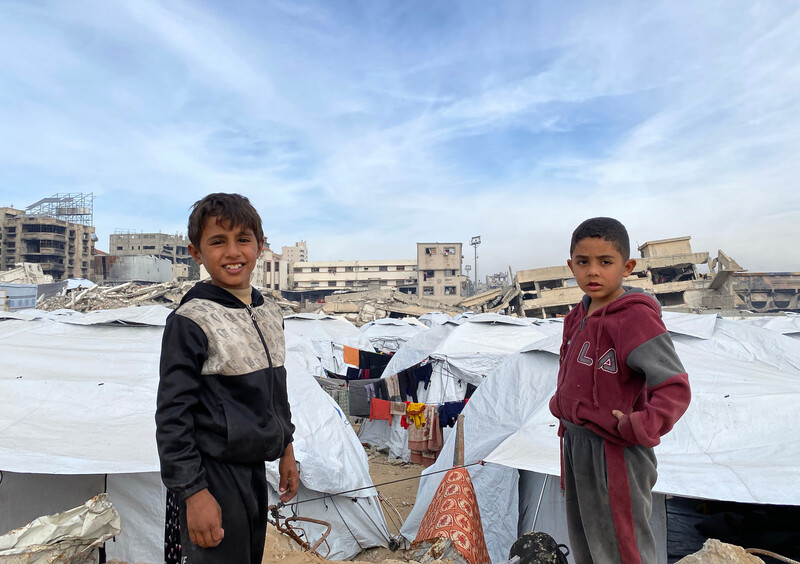Rights and Accountability 12 December 2024

The Israeli army is forcing Palestinian families to flee Beit Lahiya, in north Gaza, to makeshift tent encampments in Gaza City, 10 December.
APA imagesThe following is from the news roundup during the 11 December livestream. Watch the entire episode here.
Israel’s campaign of systematic slaughter, forced displacement, destruction and starvation in north Gaza is now in its tenth week, while airstrikes and massacres are being carried out across all areas of the coastal enclave.
Palestinians in north Gaza endured more rounds of forced displacement this past week, as Israeli forces ordered approximately 5,500 people sheltering in schools in Beit Lahiya to go to Gaza City.
Journalist Ibrahim al-Khalili reported from north Gaza as people were forced to leave, amidst Israeli tank shelling, on 5 December.
The United Nations says that about 8,000 people have been forcibly displaced to Gaza City from the northern areas since the end of November.
On 11 December, an Israeli attack in Beit Lahiya killed at least 20 people living in the multi-story home of the Abu Tarabish family.
On Tuesday, the Israeli army bombed a residential building in Beit Hanoun, in the corner of northeastern Gaza, killing 25 people and injuring dozens more.
The Gaza government media office stated that “the occupation army knew that this residential building contained dozens of displaced civilians, and that the majority of them were children and women who were displaced from their homes and civilian residential neighborhoods.”
In Beit Lahiya, Israeli forces carried out a series of massacres in and near the Kamal Adwan hospital in the last several days.
On Friday, 6 December, Israel launched yet another attack on the hospital itself, including firing directly on an ambulance near the hospital compound. Field teams with Euro-Med Human Rights Monitor reported that Israeli troops used Palestinian detainees as human shields, “forcing them to warn hospital staff that all displaced persons and companions of patients must leave the premises and head to areas controlled by Israeli forces. Many were arrested upon arrival, while others were forced to flee to a checkpoint in the Civil Administration [an Israeli military body] area and eventually to Gaza City.”Israel bombed the hospital’s vicinity while ordering medical staff and patients to leave, according to Euro-Med. The siege lasted several hours, leaving between 30 and 50 people dead in nearby streets and homes.
A surgical delegation from Indonesia was also forcibly evacuated from the hospital by the Israeli army, leaving the hospital without a single surgeon.
According to the hospital’s director, Dr. Hussam Abu Safiya, four members of his medical staff were killed and many others were injured.Abu Safiya added that the Israeli forces targeted oxygen generators, leaving only two inexperienced surgeons to handle critical cases. Despite their limited expertise, they began performing surgeries to save 20 critically injured individuals.
Less than 24 hours after Israeli drones bombed Kamal Adwan Hospital, Israeli forces attacked it again, killing 16-year-old Mahmoud Abu al-Aish, who used a wheelchair, while he was heading to the radiology department, according to the Gaza health ministry.
On Saturday, 7 December, Israel once again targeted the hospital. This video is from journalist Anas al-Sharif, recorded inside the hospital: Hussam Abu Safiya, the hospital’s director, reported on Saturday that Israel had targeted the intensive care unit and surgery wards, as well as the engineering and maintenance departments. The attacks injured three children, including one who was already hospitalized, he said.He described the assault as barbaric.
Speaking to the health ministry in Gaza, Abu Safiya said that the hospital was hit with more than 100 projectile bombs along with quadcopter drones, which fired at every window on the west side of the hospital building.
In the first week of December, Kamal Adwan Hospital suffered more than 10 direct attacks, injuring over 22 people, including medical personnel.
Israeli forces repeatedly attacked the Indonesian Hospital, also in Beit Lahiya, this past week, injuring three medical staff and six patients on 8 December.
On 10 December, the health ministry issued an urgent appeal on behalf of staff and patients at the Indonesian Hospital, saying that 60 wounded patients are at risk of death due to the lack of food and water.
“The humanitarian situation inside the hospital has become extremely dangerous, as the wounded lack basic needs, which increases their suffering under the difficult conditions imposed by the occupation forces,” the health ministry added.
Displaced Palestinians burned alive in al-Mawasi
In al-Mawasi, which has become a tent city on the sand dunes on the coast of Gaza, Israel again bombed displaced people on 4 December, burning them alive.
According to Euro-Med Human Rights Monitor, 22 Palestinians, including children, were killed in the assault, and nearly 20 suffered burn injuries.Around 6 pm, Israeli aircraft and helicopter gunships “fired multiple missiles at the tents of displaced people in Mawasi Khan Younis, an area Israel claims to be a safe humanitarian zone. The displaced people were burned alive in their ramshackle tents,” Euro-Med stated.
Based on details collected by the human rights group’s field team, the Israeli army “deliberately targeted civilians.”
Euro-Med says that “Israel first ordered an evacuation of part of the area, and an Israeli helicopter fired a missile at the displaced people as they were evacuating. The raids were subsequently repeated across a 700-meter area, directly striking the displaced people’s tents and setting them ablaze.”
The Gaza director of Medical Aid for Palestinians stated that the attack on al-Mawasi “has proven once again that nowhere is safe in Gaza from Israeli military attacks. People there have been left in a constant state of fear and psychological distress, haunted by the fact that there is no place for them to shelter.”
Relentless attacks on central Gaza
In central Gaza, Israel has been targeting areas in Nuseirat, al-Bureij and Deir al-Balah.
At least five Palestinians were killed on 11 December in Nuseirat and Deir al-Balah as Israeli aircraft bombed central Gaza.The UN reported that 34 Palestinians, including at least six children, were killed in an Israeli attack on a residential building on 6 December in Nuseirat refugee camp.
On 8 December, at least 11 Palestinians, including children, were killed and bodies were ripped to shreds when Israel bombed a house in al-Bureij.
In Nuseirat, four children – three boys and a girl between the ages of 5 and 11 – were killed near a local food distribution point, while they were in line for a meal on 4 December, according to UNICEF.
The children’s agency stated, “Day after day, week after week for nearly 14 months now, Gaza has been nothing short of hell on earth. No child should have to endure such atrocities and carnage, and no parent should have to bury their child.”
“Gaza has become a graveyard for children and families,” UNICEF added.
“The overall humanitarian response in Gaza is teetering on the brink of full collapse. The lives of virtually all children are at risk or have been shattered by unimaginable trauma, loss and deprivation. Their safety and access to essential humanitarian aid are not being facilitated as explicitly demanded by international law.”
Attacks in and around Deir al-Balah killed five members of one family, including children, early Sunday morning as they slept in a camp for displaced people.
And four children were killed in Maghazi on Monday as they played in front of their home.
Our contributor Abubaker Abed has been documenting repeated attacks by Israeli warplanes, helicopters and tanks in Maghazi, Nuseirat, al-Bureij and around Deir al-Balah for the last several days.And in Rafah, in southern Gaza, Israel attacked a group of Palestinians lining up to buy flour on Sunday, killing 10 people.
Starvation intensifies
The United Nations stated that the combination of access impediments to aid with “ongoing hostilities, the breakdown of public order and safety, the near total lack of commercial good entries, and exorbitant prices of the few basic commodities still available on the market have all contributed to a deterioration in dietary diversity” across Gaza.
In November, bread and legumes dominated household diets for the second consecutive month, with almost no consumption of vegetables, meat and eggs, the UN added.
A recent survey conducted by the UN children’s agency UNICEF showed that nearly 100 percent of children “between 6 and 23 months of age, and pregnant and breastfeeding women in Gaza city, Deir al-Balah and Khan Younis, are not meeting minimum dietary diversity,” defined as “receiving foods from at least four out of seven food groups.”The UN agency for sexual and reproductive rights issued a report this week that says that nearly 50 of its trucks, loaded with reproductive health equipment and supplies, including medicines that prevent women hemorrhaging during childbirth, tents, disposable sanitary pads, hygiene kits and generators are stalled at the border, waiting to enter Gaza.
Some trucks have been stranded since early September, the UN says. Only 41 percent of planned UN aid movements were facilitated in November; none was permitted to northern Gaza.
Highlighting community
Finally, as we always do, we wanted to share images of people expressing defiance and resilience in the face of Israel’s campaign of destruction.
This week, Translating Falasteen and the Sameer Project, local social media and aid groups, honored the sanitation workers in North Gaza.
These workers are mostly volunteers, receiving irregular and scarce wages, and Translating Falasteen and the Sameer Project handed out cash in envelopes. The narrator says, “Today is day 430 of the war. And despite the difficult circumstances, they are creating hope. And by cleaning our streets in Gaza, Gaza will be, God willing, even more beautiful than it once was. Sanitation workers are the ones creating hope after 400 days.”






Comments
Gaza
Permalink Barbara Lyons replied on
I may be a drop in the bucket but I ordered all my Christmas and Chanukah cards from UNICEF and have done so for years. The Zionist project must be stopped>
Noras' article "Gaza Has Become a Graveyard for Children"
Permalink lenser replied on
A great, hard hitting truth who's perpetrators will ultimately pay for, their collective consciousness --no matter the level of messianic brainwashing, -- child is NEVER a target.. an innocent new life without judgement, with no sides, those who are doing this --WILL BE BROUGHT TO JUSTICE.
'Gaza will be, God willing,
Permalink Shiva Shankar replied on
'Gaza will be, God willing, even more beautiful than it once was ..'
We have to get together, the citizens of the world, and make this a reality. Gaza has to become a beacon of hope for future generations of humanity.